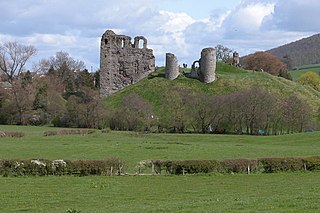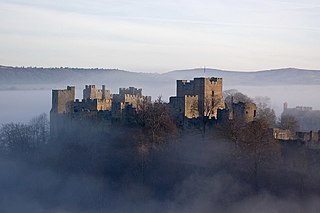
Henry de Say was a Norman nobleman who lived in Clun in Shropshire, along the medieval Welsh Marches.

Henry de Say was a Norman nobleman who lived in Clun in Shropshire, along the medieval Welsh Marches.
Henry de Say inherited the important fortification Clun Castle from his father, Robert de Say (also called Picot de Say), in 1098. [1] Henry died some time after 1130. [2] His son was Helias de Say. [3]
Helias de Say (died 1165), also called "Hellias", was a Norman nobleman who lived in Clun, Shropshire, along the medieval Welsh Marches. He is believed to have inherited Clun Castle from his father, Henry de Say, in the reign of Henry I. [4] Helias held the key fortification of Clun Castle during the years of the Anarchy. He was an important early benefactor of Haughmond Abbey. Upon his death, his only surviving child and heiress was Isabella de Say. [3]

Castles have played an important military, economic and social role in Great Britain and Ireland since their introduction following the Norman invasion of England in 1066. Although a small number of castles had been built in England in the 1050s, the Normans began to build motte and bailey and ringwork castles in large numbers to control their newly occupied territories in England and the Welsh Marches. During the 12th century the Normans began to build more castles in stone – with characteristic square keep – that played both military and political roles. Royal castles were used to control key towns and the economically important forests, while baronial castles were used by the Norman lords to control their widespread estates. David I invited Anglo-Norman lords into Scotland in the early 12th century to help him colonise and control areas of his kingdom such as Galloway; the new lords brought castle technologies with them and wooden castles began to be established over the south of the kingdom. Following the Norman invasion of Ireland in the 1170s, under Henry II, castles were established there too.

Stokesay Castle is one of the finest surviving fortified manor houses in England, and situated at Stokesay in Shropshire. It was largely built in its present form in the late 13th century by Laurence of Ludlow, on the earlier castle founded by its original owners the de Lacy family, from whom it passed to their de Verdun heirs, who retained feudal overlordship of Stokesay until at least 1317. Laurence 'of' Ludlow was one of the leading wool merchants in England, who intended it to form a secure private house and generate income as a commercial estate. Laurence's descendants continued to own the castle until the 16th century, when it passed through various private owners. By the time of the outbreak of the First English Civil War in 1642, Stokesay was owned by William Craven, 1st Earl of Craven (1608–1697), a supporter of King Charles I. After the Royalist war effort collapsed in 1645, Parliamentary forces besieged the castle in June and quickly forced its garrison to surrender. Parliament ordered the property to be slighted, but only minor damage was done to the walls, allowing Stokesay to continue to be used as a house by the Baldwyn family until the end of the 17th century.
John Fitzalan II (1223–1267), Lord of Oswestry, Clun, and Arundel, was an English nobleman and Marcher Lord with lands in the Welsh Marches.

Clun is a town in south west Shropshire, England, and the Shropshire Hills Area of Outstanding Natural Beauty. The 2011 census recorded 680 people living in the town. Research by the Campaign for the Protection of Rural England suggests that Clun is one of the most tranquil locations in England.

Clun Castle is a medieval ruined castle in Clun, Shropshire, England. Clun Castle was established by the Norman lord Robert de Say after the Norman invasion of England and went on to become an important Marcher lord castle in the 12th century, with an extensive castle-guard system. Owned for many years by the Fitzalan family, Clun played a key part in protecting the region from Welsh attack until it was gradually abandoned as a property in favour of the more luxurious Arundel Castle. The Fitzalans converted Clun Castle into a hunting lodge in the 14th century, complete with pleasure gardens, but by the 16th century the castle was largely ruined. Slighted in 1646 after the English Civil War, Clun remained in poor condition until renovation work in the 1890s.
Shropshire was established during the division of Saxon Mercia into shires in the 10th century. It is first mentioned in 1006. After the Norman Conquest it experienced significant development, following the granting of the principal estates of the county to eminent Normans, such as Roger De Montgomery and his son Robert de Bellême.

Fulk FitzWarin, variant spellings, the third, was a prominent representative of a marcher family associated especially with estates in Shropshire and at Alveston in Gloucestershire. In young life, early in the reign of King John (1199–1216), he won notoriety as the outlawed leader of a roving force striving to recover his familial right to Whittington Castle in Shropshire, which John had granted away to a Welsh claimant. Progressively rehabilitated, and enjoying his lordship, he endured further setbacks in 1215–1217.
In medieval England, Wales and the Channel Islands a licence to crenellate granted the holder permission to fortify his property. Such licences were granted by the king, and by the rulers of the counties palatine within their jurisdictions, i.e. by the Bishops of Durham, the Earls of Chester, and after 1351 by the Dukes of Lancaster.
Walter de Clifford (1113–1190) was an Anglo-Norman Marcher Lord of Bronllys Castle on the Welsh border, and was feudal baron of Clifford, seated at Clifford Castle in Herefordshire.
Richard de Belmeis I was a medieval cleric, administrator, judge and politician. Beginning as a minor landowner and steward in Shropshire, he became Henry I's chief agent in the Welsh Marches and in 1108 was appointed Bishop of London. He founded St Osyth's Priory in Essex and was succeeded by a considerable dynasty of clerical politicians and landowners.
Alan fitz Flaad was a Breton knight, probably recruited as a mercenary by Henry I of England in his conflicts with his brothers. After Henry became King of England, Alan became an assiduous courtier and obtained large estates in Norfolk, Sussex, Shropshire, and elsewhere in the Midlands, including the feudal barony and castle of Oswestry in Shropshire. His duties included supervision of the Welsh border. He is now noted as the progenitor of the FitzAlan family, the Earls of Arundel (1267–1580), and the House of Stuart, although his family connections were long a matter of conjecture and controversy.
Baldwin de Boulers came to England in 1105 when he was granted the Lordship of Montgomery, Powys in marriage with Sybil de Falaise. Sybil was referred to as the niece of Henry I of England but is commonly believed, probably incorrectly, to be one of his illegitimate children.
Isabella de Say was an Anglo-Norman heiress. Isabella was the only surviving child of Helias de Say upon his death in 1165; Helias was the third lord of Clun, a powerful Norman stronghold in Shropshire, England, along the Welsh border. She is notable for helping to create the powerful medieval house of the FitzAlans. Isabella married William FitzAlan, the lord of nearby Oswestry, as his second wife in 1156. William died in 1160, leaving a son by his first wife, Christiana, William FitzAlan II. Isabella passed Clun Castle to him. The combined lordship of Oswestry and Clun was a significant power in the borderlands with Wales.
William Fitz Alan was a Norman nobleman who lived in Oswestry and Clun near Shrewsbury, along the medieval Welsh Marches. William was the son of William Fitz Allan, controlling the castles of Clun and Oswestry and later became the High Sheriff of Shropshire. William married a daughter of Hugh de Lacy, of which no first name is mentioned in any record known. When William came to inherit his lands in 1210, King John demanded a fee of 10,000 marks; unable to pay, William was unable to inherit. He only outlived his father by a few years, dying around Easter 1215. The estates were eventually reclaimed by his younger brother John Fitzalan.

Pain fitzJohn was an Anglo-Norman nobleman and administrator, one of King Henry I of England's "new men", who owed their positions and wealth to the king.
William FitzAlan (1085–1160) was a nobleman of Breton ancestry. He was a major landowner, a Marcher lord with large holdings in Shropshire, where he was the Lord of Oswestry, as well as in Norfolk and Sussex. He took the side of Empress Matilda during the Anarchy and underwent considerable hardship in the Angevin cause before regaining his lands and former status. William's younger brother, Walter fitz Alan, became ancestor of the royal House of Stuart.
William Pantulf was an Anglo-Norman nobleman and Baron of Wem. He was born in Hiémois, a county of Normandy, where his family had lived since around 1030. Pantulf held lands in Shropshire following the Norman Conquest of England. A vassal of Roger of Montgomery, the Earl of Shrewsbury, Pantulf was accused of murdering Roger's wife but proved his innocence of the charge by a trial by ordeal. When Roger's son Robert of Belleme rebelled against King Henry I of England, Pantulf did not take part and sided with the king. Upon his death, which most likely occurred in 1112, William's eldest son Philip inherited his Norman lands, and his second son Robert received the English lands.
William FitzAlan was a Norman nobleman who lived in Oswestry and Clun near Shrewsbury, along the medieval Welsh Marches. William was the son of William FitzAlan, controlling the castles of Clun and Oswestry and later became the High Sheriff of Shropshire. Many people today will often confuse William with his father, as their death dates are similar by 5 years. Because of this, it is important to know that this William was married to Mary Erington, the daughter of Thomas. William's father William married the daughter of Hugh de Lacy, whose name is never mentioned in any documents. When William came to inherit his lands in 1210, King John demanded a fee of 10,000 marks; unable to pay, William was unable to inherit. He only outlived his father by a few years, dying around Easter 1215. The estates were eventually reclaimed by his younger brother John Fitzalan.
William FitzAlan was a Norman nobleman who lived in Oswestry and Clun, near Shrewsbury, along the medieval Welsh Marches. William was the son of William FitzAlan and Christina.

de Say is the surname of an old Norman noble family originating from Sai, Orne. The first records are about William de Say and Picot de Say, Norman conquerors. The de Say family, held lands in England and France.